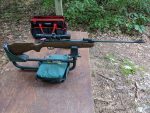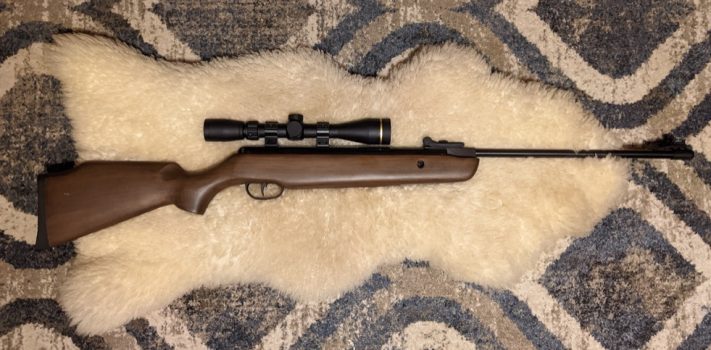I recently picked up a Remington Vantage pellet gun at a garage sale for $50. The most surprising thing about that purchase was that my wife, “Kari”, called the gun to my attention. Kari cannot be described in any way as a gun enthusiast. She tolerates guns as a necessary evil, but steadfastly refuses to touch one herself under any circumstances. So I was shocked when she not only drew the pellet gun to my attention, but also supported the purchase and even carried the gun to the car for me while I carried the much heavier box containing her purchases.
I was hoping that the gun would provide a reasonably priced alternative for marksmanship practice and for pest control. At the time of this writing, the current model of this gun (the Crosman Vantage NP) was available for $188.71 from crosman.com. Unfortunately, the gun was not accurate enough to be a good choice for either marksmanship practice or pest control. I would recommend seeking other alternatives.
Description
The Remington Vantage is a single-shot, break-barrel air rifle available in .177 and .22 calibers. The model I have is .177 caliber. It has a wooden stock, and an 18.5 inch barrel. The barrel seems much longer than that, since the compression chamber and other mechanical parts associated with the action are 14 inches long. Overall, the rifle measures 44.5 inches from recoil pad to muzzle, making it longer than many centerfire rifles. It is heavier than many centerfire rifles as well, weighing in at 7.79 pounds. With a muzzle velocity of up to 1200 fps, it is significantly more powerful than the Crosman 760 of my childhood. As a result, the Owner’s Manual recommends that the airgun be used by adults only.
The First Range Session
I took the rifle to the range behind my pole barn for some testing. I set up a table 25 yards from the target stand, put a lead sled on the table, and then placed the rifle in the lead sled. I did not use the lead sled because of any concern about recoil, but because it provides such a marvelously stable shooting platform.
I began testing with some 50 year-old pellets left over from my childhood. I had found them in my father’s gun cabinet after his passing some years ago. The old pellets had developed a white powdery layer of oxidation on the outside.
My initial groups were horrible, so I switched to new Crosman Premier 7.9 grain hp pellets hoping for better groups. The groups were slightly better, but still pretty bad.
I then tried switching to shooting from sandbags rather than using the lead sled. The groups were still woefully and pitifully inadequate.
I was starting to think that I had bought a lemon, but I decided to try taking off the scope and using the iron sights instead. My results improved dramatically. The initial poor results were not primarily due to the rifle but rather the scope. The CenterPoint 4×32 scope that came with the rifle was absolutely horrible. It was blurry and could not seem to hold a zero.
The Manual
Following the first range session, I downloaded the manual from the internet to see if it had any tips for maintaining the rifle. I was able to print the entire manual on one side of an 11×17 sheet of paper. The manual contained a number of interesting pieces of information:
∙ It recommended never dry firing the rifle, since this can damage the mechanism.
∙ It noted that the trigger is adjustable for length of second stage pull, but is not adjustable for weight.
∙ Firing the rifle when the barrel is in the open (down) position may damage the mechanism.
∙ The only way to unload the rifle once it is loaded is to fire it in a safe direction.
∙ The rifle should not be stored cocked or cocked and loaded, since this is hard on the mechanism. I was especially interested in this information, since the rifle was loaded when I purchased it. This was one case when always treating a gun as if it is loaded was excellent advice.
∙ The manual recommends placing a drop of oil in the compression chamber every few hundred shots.
First Cleaning
I broke the mechanism open just enough to put a drop of oil in the compression chamber without cocking the gun, and put a light film of CLP over the exterior metal surfaces. No further cleaning was necessary.
Mounting a Different Scope
I removed the CenterPoint scope from its rings, and installed a UTG 3-9×32 Bugbuster scope in the rings instead. I had not been happy with how the UTG scope had worked on other platforms, but decided to give it another chance before getting rid of it.
I then determined the proper eye relief, leveled the rifle and scope, tightened the rings evenly, and focused the scope. The best short summary of that process that I am aware of can be found here.
The Second Range Session
I fired three different groups to zero the UTG scope, and then fired a number of groups to test the scope/rifle combo. The groups were adequate, but not significantly better than I had been getting with the iron sights.
I then removed the scope, and verified that I could indeed get groups with the iron sights that were just as good as the groups I was getting with the scope. I was not sure if this was due to inadequacies with the scope, or if my accuracy with iron sights exhausted the limitations of the intrinsic accuracy of the rifle.
I decided that further testing was called for.
Try, Try Again
Prior to the third range session, I mounted a Leupold VX-Freedom 3-9X40mm scope on the gun. I again determined the proper eye relief, leveled the rifle and scope, tightened the rings evenly, and focused the scope.
 I have previously used the same Leupold scope with great success with a Browning BAR Mk III in .243, a Ruger 10/22 in .22 LR, a Saiga .223 in (of course) .223, a Ruger American Ranch Rifle in 7.62X39, a Mossberg Patriot Predator in .243, a Rock River Arms All Terrain Hunter in 5.56×45, and a Benelli Lupo BE.S.T. in .308. I had experienced excellent results from the scope with all of these rifles, so I knew that it was a good scope. If the results with the Leupold scope were disappointing, I would know that it was the rifle and not the scope that was the problem.
I have previously used the same Leupold scope with great success with a Browning BAR Mk III in .243, a Ruger 10/22 in .22 LR, a Saiga .223 in (of course) .223, a Ruger American Ranch Rifle in 7.62X39, a Mossberg Patriot Predator in .243, a Rock River Arms All Terrain Hunter in 5.56×45, and a Benelli Lupo BE.S.T. in .308. I had experienced excellent results from the scope with all of these rifles, so I knew that it was a good scope. If the results with the Leupold scope were disappointing, I would know that it was the rifle and not the scope that was the problem.
In spite of my best efforts, I could only shoot two-inch groups at 25 yards with the gun using the Leupold scope. This would be an M.O.A. of approximately eight. Since pests tend to be rather small, a pellet gun to be used for pest control should be able to shoot a one inch group or smaller at 25 yards (an M.O.A. of four or less). The Remington Vantage could not meet this minimum standard.
Since the disappointing results that I achieved with the UTG scope were due to the limitations of the rifle rather than the scope, I decided to give that scope another chance, and plan to test it in the future with a rifle that I know to be capable of good groups.
Airgun History
The oldest surviving airgun is a bellows-powered unit from about 1580. It is currently a part of the collections of the Livrustkammeren Museum in Stockholm Sweden.
In the 17th through 19th centuries, airguns were used for both hunting and in military use. Their primary advantages over the firearms of the day included more reliable performance during wet weather, a higher rate of fire when fully charged, a quieter report, and no muzzle flash or smoke to give away the position of the shooter. The disadvantage was that they were more complex than the black powder firearms of the day, and were difficult to maintain.
Meriwether Lewis of the Lewis and Clark Expedition carried an airgun on the expedition that was capable of firing 22 shots on a single charge of air. He used it primarily to impress the Indians that the expedition encountered with the capabilities of a high-capacity semi-automatic rifle.
Sir Arthur Conan Doyle revealed a familiarity with airguns by equipping Coronel Sebastian Moran with one for his assassination attempt upon Sherlock Holmes in the short story “The Adventure of the Empty House.”
Much of the early, commercially successful, mass production of airguns in the United States was centered in Plymouth Michigan, where the Markham Air Rifle Company and the Plymouth Air Rifle Company (later Daisy Manufacturing Company) engaged in stiff competition beginning in the 1880’s. Eventually Daisy won out, purchasing their competitor in 1916.
Conclusions
With pellets currently costing about a penny apiece, pellet guns may offer a reasonably priced alternative for marksmanship training and pest control. The Remington Vantage pellet gun looks like a decent option, but was unable to provide sufficient accuracy for the desired uses. I would recommend seeking other alternatives for your survival battery.
Disclaimer
Caldwell provided me with a Lead Sled 3 for a review I wrote some time back. Leupold provided me with a VX-Freedom 3-9X40mm scope for a different review that I did about the same time. I did not receive any other financial or other inducement to mention any vendor, product, or service in this article.










